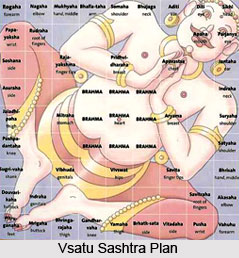 Vastu Shastra states that there should not be any obstacles in front of the main entrance of an establishment. There are different kinds of obstacles and one of them is the Dwar Vedh. The obstacle for air and light in front of the main entrance or the compound wall is known as dwar vedh. These obstructions can be in the shape of electric pole, telephone pole, tree, water tank and others. However if the distance between the obstacles and the building is equal to the twice the height of the building then such obstructions will not have any negative effects.
Vastu Shastra states that there should not be any obstacles in front of the main entrance of an establishment. There are different kinds of obstacles and one of them is the Dwar Vedh. The obstacle for air and light in front of the main entrance or the compound wall is known as dwar vedh. These obstructions can be in the shape of electric pole, telephone pole, tree, water tank and others. However if the distance between the obstacles and the building is equal to the twice the height of the building then such obstructions will not have any negative effects.
a) Swar Vedh: No creaking sound should be heard while opening the door. Such sounds are considered quite inauspicious.
b) Kup Vedh: There should not be any septic tank, underground storage tank, boring, underground drainage or canals in front of the main entrance. This may lead to loss of wealth and property.
c) Bramha Vedh: If there is an oil expeller, grinding mill or edge sharpener machine in front of the main entrance it is known as Bramhvedh. Life becomes unstable and there will be clashes in the family.
d) Kil Vedh: A peg to tie a goat, cow, buffalo or dog in front of the main entrance acts as obstructions too. This can hamper the progress of the family.
e) Stambh Vedh:There should not be any pole, electric pole or telephone pole in front of the main entrance. Stambh Vedh may lead to differences of opinion amongst the family members or business partners. There will be long drawn quarrels, which will adversely affect the progress.
f) Vastu Vedh: There should not be storeroom, garage, outhouse or watchman cabin in front of the main entrance. This results in loss of property.
g) Marg Vedh: Furnaces should not be constructed outside the compound gate in the East, the Northeast or the North directions. There also should not be any tank, pit or stagnant pool of water in South, the Southeast or the Southwest directions. These things are obstructions just outside the compound wall and are known as Marg Vedh. The head of the family faces many obstacles in his way.
h) The main: entrance of a building should not be located exactly at the middle of the length or the breadth of the house.
i)It should also be kept in mind that water does not collect in front of the main entrance due to leakage or any other reason. This may prove harmful to children.
j) Accumulation of mudstones or bricks in front of the main entrance also has a negative impact. This may hamper progress as well.
k) The main gate should not be higher than the compound wall. This affects the progress of the head of the family.
l) No structure or its corner should face the main entrance of the building.
m) Do not build common entrances for two houses. Unwanted troubles may take place because of such obstructions.
n) Bhawan Vedh: Although generally it does not happen but the compound wall should never be higher than the building. This hinders the economic progress of the family.
o) Dilapidated, abandoned building or remnants of an old building in front of the main entrance of any residential or commercial building have to be removed, as there would be a negative impact. The owner will face day-to-day losses and the business has chances of closing down too.









